Analyzing the Impact of Deregulation on Australian Tertiary Fees
VerifiedAdded on 2020/03/16
|6
|1270
|104
Report
AI Summary
This report examines the implications of deregulating Australian tertiary education fees. It begins by explaining the government's initial price ceiling on tertiary fees, designed to ensure affordability and market efficiency. The report then analyzes the impact of deregulation, using supply and demand graphs to illustrate the effects of removing the price ceiling. The consequences of deregulation, including the concept of price elasticity, are discussed, demonstrating how increased fees can lead to decreased enrollment. Furthermore, the report assesses the impact on market efficiency, showing the loss of efficiency through deadweight loss, and the effect on equity, highlighting increased socioeconomic inequality. The report references relevant sources to support its findings, providing a comprehensive overview of the economic effects of deregulating Australian tertiary fees.
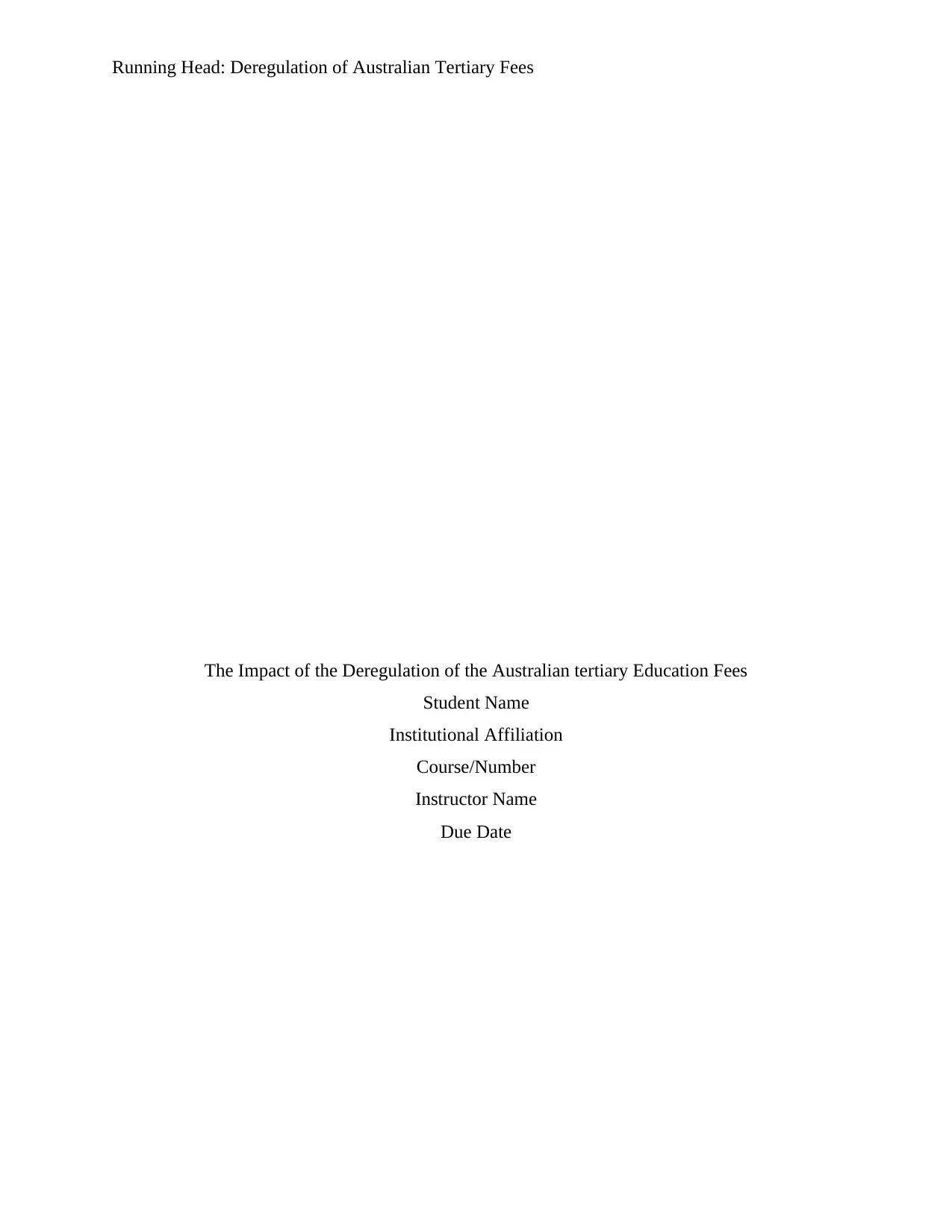
Running Head: Deregulation of Australian Tertiary Fees
The Impact of the Deregulation of the Australian tertiary Education Fees
Student Name
Institutional Affiliation
Course/Number
Instructor Name
Due Date
The Impact of the Deregulation of the Australian tertiary Education Fees
Student Name
Institutional Affiliation
Course/Number
Instructor Name
Due Date
Paraphrase This Document
Need a fresh take? Get an instant paraphrase of this document with our AI Paraphraser
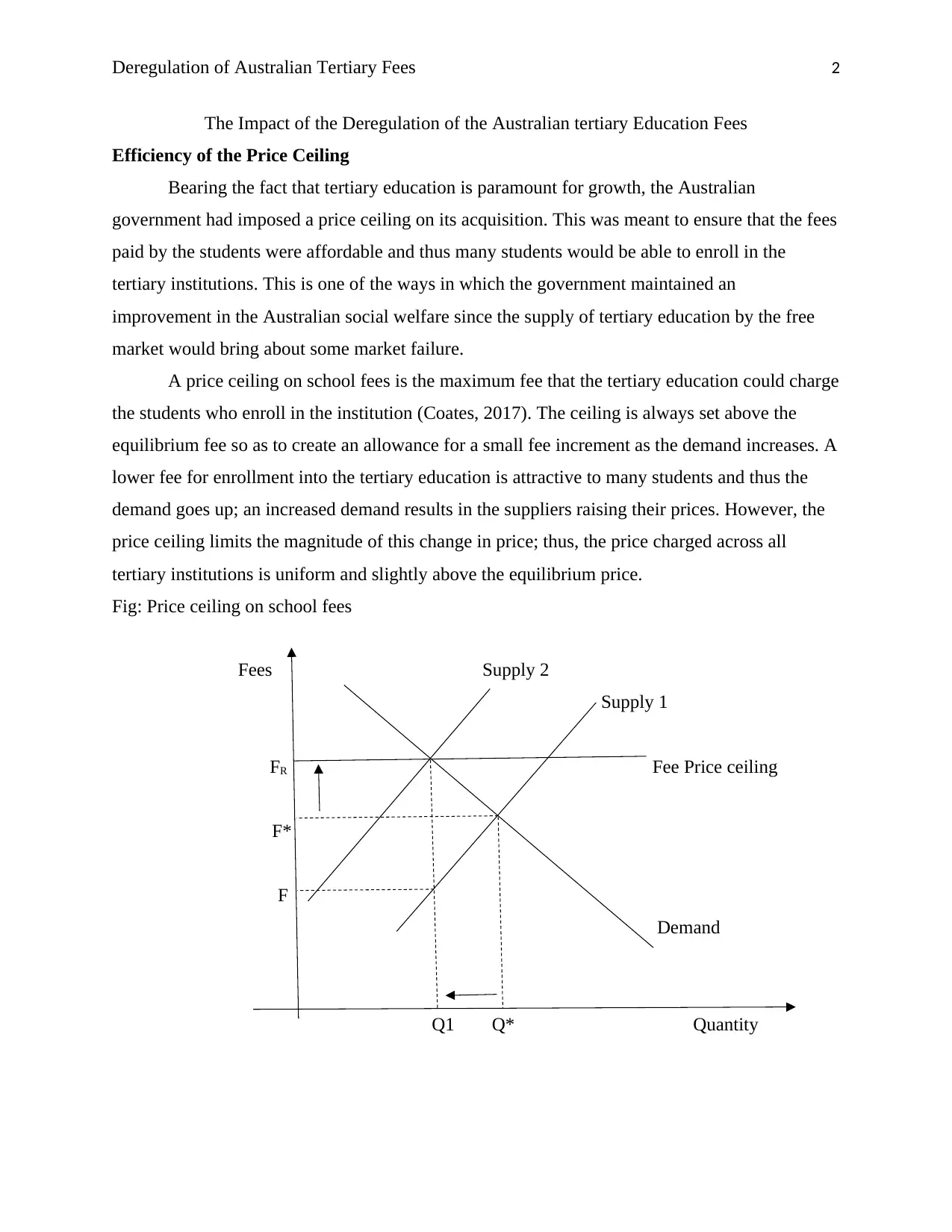
Deregulation of Australian Tertiary Fees 2
The Impact of the Deregulation of the Australian tertiary Education Fees
Efficiency of the Price Ceiling
Bearing the fact that tertiary education is paramount for growth, the Australian
government had imposed a price ceiling on its acquisition. This was meant to ensure that the fees
paid by the students were affordable and thus many students would be able to enroll in the
tertiary institutions. This is one of the ways in which the government maintained an
improvement in the Australian social welfare since the supply of tertiary education by the free
market would bring about some market failure.
A price ceiling on school fees is the maximum fee that the tertiary education could charge
the students who enroll in the institution (Coates, 2017). The ceiling is always set above the
equilibrium fee so as to create an allowance for a small fee increment as the demand increases. A
lower fee for enrollment into the tertiary education is attractive to many students and thus the
demand goes up; an increased demand results in the suppliers raising their prices. However, the
price ceiling limits the magnitude of this change in price; thus, the price charged across all
tertiary institutions is uniform and slightly above the equilibrium price.
Fig: Price ceiling on school fees
Fees Supply 2
Supply 1
FR Fee Price ceiling
F*
F
Demand
Q1 Q* Quantity
The Impact of the Deregulation of the Australian tertiary Education Fees
Efficiency of the Price Ceiling
Bearing the fact that tertiary education is paramount for growth, the Australian
government had imposed a price ceiling on its acquisition. This was meant to ensure that the fees
paid by the students were affordable and thus many students would be able to enroll in the
tertiary institutions. This is one of the ways in which the government maintained an
improvement in the Australian social welfare since the supply of tertiary education by the free
market would bring about some market failure.
A price ceiling on school fees is the maximum fee that the tertiary education could charge
the students who enroll in the institution (Coates, 2017). The ceiling is always set above the
equilibrium fee so as to create an allowance for a small fee increment as the demand increases. A
lower fee for enrollment into the tertiary education is attractive to many students and thus the
demand goes up; an increased demand results in the suppliers raising their prices. However, the
price ceiling limits the magnitude of this change in price; thus, the price charged across all
tertiary institutions is uniform and slightly above the equilibrium price.
Fig: Price ceiling on school fees
Fees Supply 2
Supply 1
FR Fee Price ceiling
F*
F
Demand
Q1 Q* Quantity
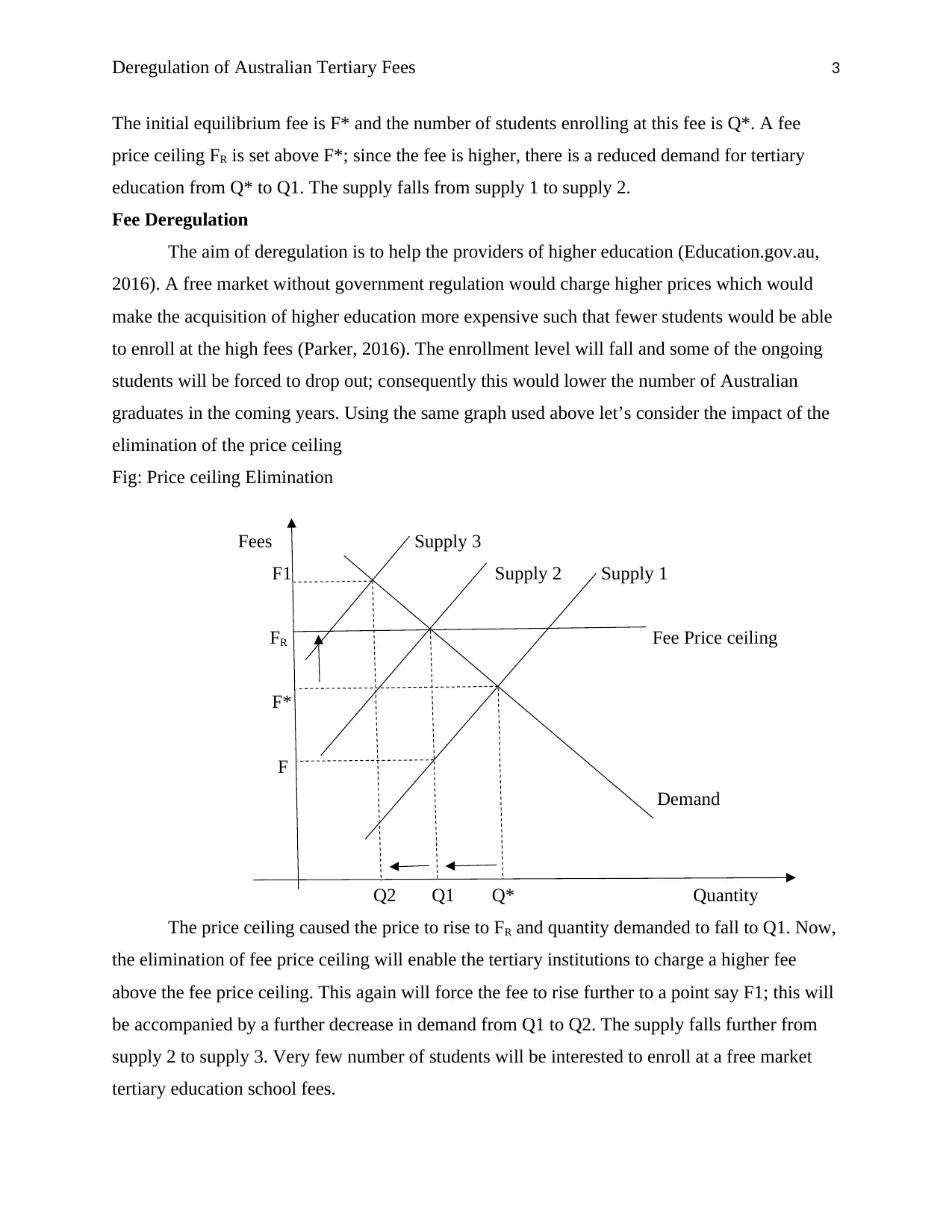
Deregulation of Australian Tertiary Fees 3
The initial equilibrium fee is F* and the number of students enrolling at this fee is Q*. A fee
price ceiling FR is set above F*; since the fee is higher, there is a reduced demand for tertiary
education from Q* to Q1. The supply falls from supply 1 to supply 2.
Fee Deregulation
The aim of deregulation is to help the providers of higher education (Education.gov.au,
2016). A free market without government regulation would charge higher prices which would
make the acquisition of higher education more expensive such that fewer students would be able
to enroll at the high fees (Parker, 2016). The enrollment level will fall and some of the ongoing
students will be forced to drop out; consequently this would lower the number of Australian
graduates in the coming years. Using the same graph used above let’s consider the impact of the
elimination of the price ceiling
Fig: Price ceiling Elimination
Fees Supply 3
F1 Supply 2 Supply 1
FR Fee Price ceiling
F*
F
Demand
Q2 Q1 Q* Quantity
The price ceiling caused the price to rise to FR and quantity demanded to fall to Q1. Now,
the elimination of fee price ceiling will enable the tertiary institutions to charge a higher fee
above the fee price ceiling. This again will force the fee to rise further to a point say F1; this will
be accompanied by a further decrease in demand from Q1 to Q2. The supply falls further from
supply 2 to supply 3. Very few number of students will be interested to enroll at a free market
tertiary education school fees.
The initial equilibrium fee is F* and the number of students enrolling at this fee is Q*. A fee
price ceiling FR is set above F*; since the fee is higher, there is a reduced demand for tertiary
education from Q* to Q1. The supply falls from supply 1 to supply 2.
Fee Deregulation
The aim of deregulation is to help the providers of higher education (Education.gov.au,
2016). A free market without government regulation would charge higher prices which would
make the acquisition of higher education more expensive such that fewer students would be able
to enroll at the high fees (Parker, 2016). The enrollment level will fall and some of the ongoing
students will be forced to drop out; consequently this would lower the number of Australian
graduates in the coming years. Using the same graph used above let’s consider the impact of the
elimination of the price ceiling
Fig: Price ceiling Elimination
Fees Supply 3
F1 Supply 2 Supply 1
FR Fee Price ceiling
F*
F
Demand
Q2 Q1 Q* Quantity
The price ceiling caused the price to rise to FR and quantity demanded to fall to Q1. Now,
the elimination of fee price ceiling will enable the tertiary institutions to charge a higher fee
above the fee price ceiling. This again will force the fee to rise further to a point say F1; this will
be accompanied by a further decrease in demand from Q1 to Q2. The supply falls further from
supply 2 to supply 3. Very few number of students will be interested to enroll at a free market
tertiary education school fees.
⊘ This is a preview!⊘
Do you want full access?
Subscribe today to unlock all pages.

Trusted by 1+ million students worldwide
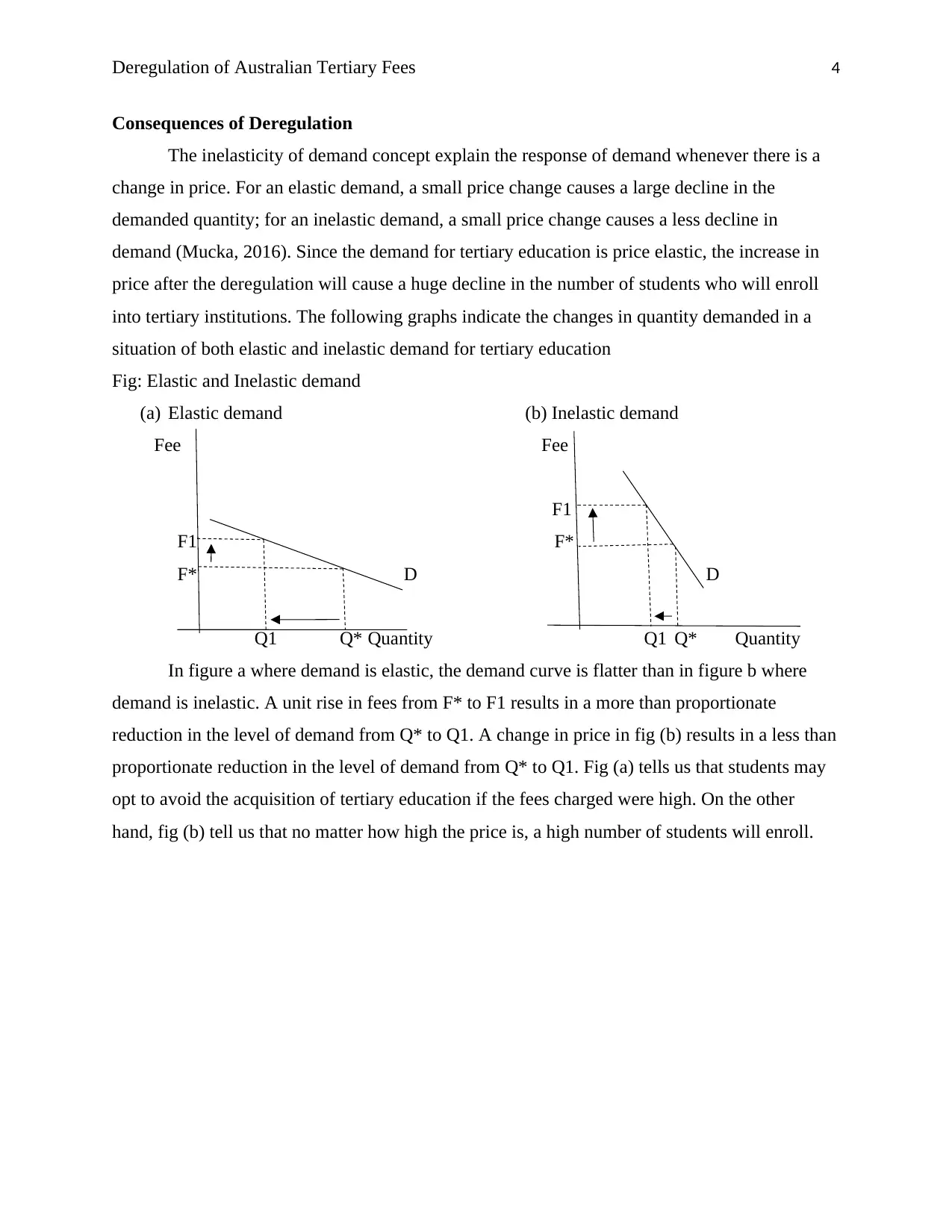
Deregulation of Australian Tertiary Fees 4
Consequences of Deregulation
The inelasticity of demand concept explain the response of demand whenever there is a
change in price. For an elastic demand, a small price change causes a large decline in the
demanded quantity; for an inelastic demand, a small price change causes a less decline in
demand (Mucka, 2016). Since the demand for tertiary education is price elastic, the increase in
price after the deregulation will cause a huge decline in the number of students who will enroll
into tertiary institutions. The following graphs indicate the changes in quantity demanded in a
situation of both elastic and inelastic demand for tertiary education
Fig: Elastic and Inelastic demand
(a) Elastic demand (b) Inelastic demand
Fee Fee
F1
F1 F*
F* D D
Q1 Q* Quantity Q1 Q* Quantity
In figure a where demand is elastic, the demand curve is flatter than in figure b where
demand is inelastic. A unit rise in fees from F* to F1 results in a more than proportionate
reduction in the level of demand from Q* to Q1. A change in price in fig (b) results in a less than
proportionate reduction in the level of demand from Q* to Q1. Fig (a) tells us that students may
opt to avoid the acquisition of tertiary education if the fees charged were high. On the other
hand, fig (b) tell us that no matter how high the price is, a high number of students will enroll.
Consequences of Deregulation
The inelasticity of demand concept explain the response of demand whenever there is a
change in price. For an elastic demand, a small price change causes a large decline in the
demanded quantity; for an inelastic demand, a small price change causes a less decline in
demand (Mucka, 2016). Since the demand for tertiary education is price elastic, the increase in
price after the deregulation will cause a huge decline in the number of students who will enroll
into tertiary institutions. The following graphs indicate the changes in quantity demanded in a
situation of both elastic and inelastic demand for tertiary education
Fig: Elastic and Inelastic demand
(a) Elastic demand (b) Inelastic demand
Fee Fee
F1
F1 F*
F* D D
Q1 Q* Quantity Q1 Q* Quantity
In figure a where demand is elastic, the demand curve is flatter than in figure b where
demand is inelastic. A unit rise in fees from F* to F1 results in a more than proportionate
reduction in the level of demand from Q* to Q1. A change in price in fig (b) results in a less than
proportionate reduction in the level of demand from Q* to Q1. Fig (a) tells us that students may
opt to avoid the acquisition of tertiary education if the fees charged were high. On the other
hand, fig (b) tell us that no matter how high the price is, a high number of students will enroll.
Paraphrase This Document
Need a fresh take? Get an instant paraphrase of this document with our AI Paraphraser
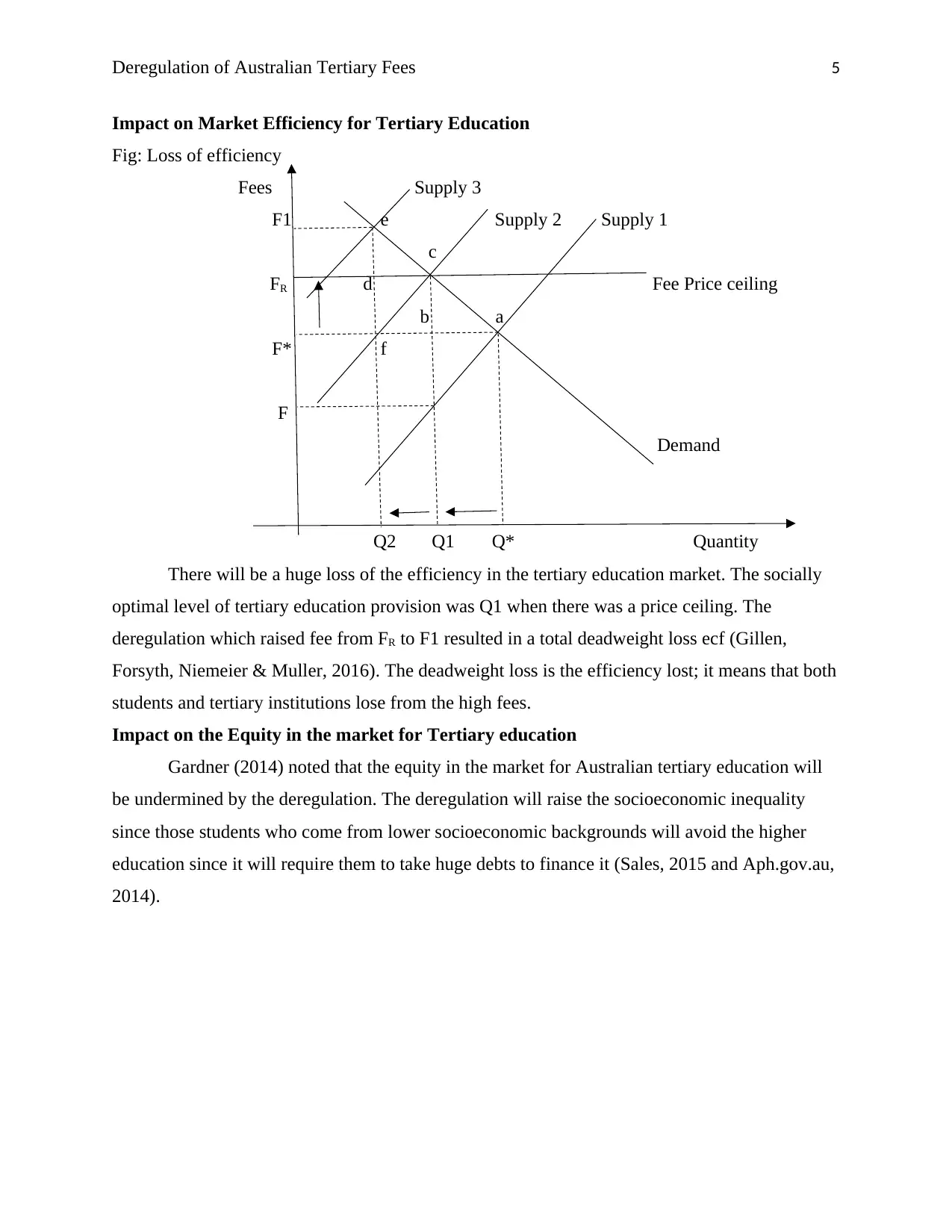
Deregulation of Australian Tertiary Fees 5
Impact on Market Efficiency for Tertiary Education
Fig: Loss of efficiency
Fees Supply 3
F1 e Supply 2 Supply 1
c
FR d Fee Price ceiling
b a
F* f
F
Demand
Q2 Q1 Q* Quantity
There will be a huge loss of the efficiency in the tertiary education market. The socially
optimal level of tertiary education provision was Q1 when there was a price ceiling. The
deregulation which raised fee from FR to F1 resulted in a total deadweight loss ecf (Gillen,
Forsyth, Niemeier & Muller, 2016). The deadweight loss is the efficiency lost; it means that both
students and tertiary institutions lose from the high fees.
Impact on the Equity in the market for Tertiary education
Gardner (2014) noted that the equity in the market for Australian tertiary education will
be undermined by the deregulation. The deregulation will raise the socioeconomic inequality
since those students who come from lower socioeconomic backgrounds will avoid the higher
education since it will require them to take huge debts to finance it (Sales, 2015 and Aph.gov.au,
2014).
Impact on Market Efficiency for Tertiary Education
Fig: Loss of efficiency
Fees Supply 3
F1 e Supply 2 Supply 1
c
FR d Fee Price ceiling
b a
F* f
F
Demand
Q2 Q1 Q* Quantity
There will be a huge loss of the efficiency in the tertiary education market. The socially
optimal level of tertiary education provision was Q1 when there was a price ceiling. The
deregulation which raised fee from FR to F1 resulted in a total deadweight loss ecf (Gillen,
Forsyth, Niemeier & Muller, 2016). The deadweight loss is the efficiency lost; it means that both
students and tertiary institutions lose from the high fees.
Impact on the Equity in the market for Tertiary education
Gardner (2014) noted that the equity in the market for Australian tertiary education will
be undermined by the deregulation. The deregulation will raise the socioeconomic inequality
since those students who come from lower socioeconomic backgrounds will avoid the higher
education since it will require them to take huge debts to finance it (Sales, 2015 and Aph.gov.au,
2014).
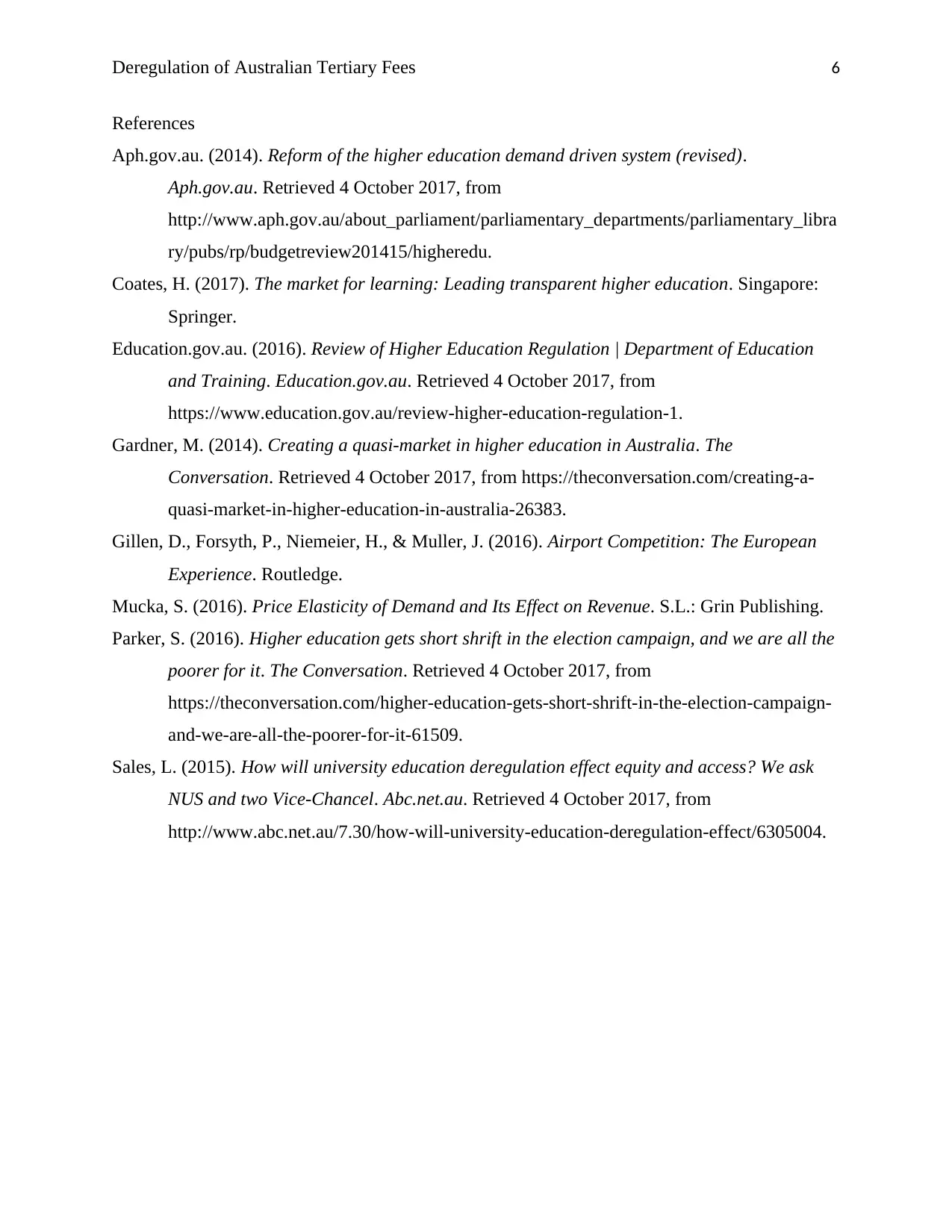
Deregulation of Australian Tertiary Fees 6
References
Aph.gov.au. (2014). Reform of the higher education demand driven system (revised).
Aph.gov.au. Retrieved 4 October 2017, from
http://www.aph.gov.au/about_parliament/parliamentary_departments/parliamentary_libra
ry/pubs/rp/budgetreview201415/higheredu.
Coates, H. (2017). The market for learning: Leading transparent higher education. Singapore:
Springer.
Education.gov.au. (2016). Review of Higher Education Regulation | Department of Education
and Training. Education.gov.au. Retrieved 4 October 2017, from
https://www.education.gov.au/review-higher-education-regulation-1.
Gardner, M. (2014). Creating a quasi-market in higher education in Australia. The
Conversation. Retrieved 4 October 2017, from https://theconversation.com/creating-a-
quasi-market-in-higher-education-in-australia-26383.
Gillen, D., Forsyth, P., Niemeier, H., & Muller, J. (2016). Airport Competition: The European
Experience. Routledge.
Mucka, S. (2016). Price Elasticity of Demand and Its Effect on Revenue. S.L.: Grin Publishing.
Parker, S. (2016). Higher education gets short shrift in the election campaign, and we are all the
poorer for it. The Conversation. Retrieved 4 October 2017, from
https://theconversation.com/higher-education-gets-short-shrift-in-the-election-campaign-
and-we-are-all-the-poorer-for-it-61509.
Sales, L. (2015). How will university education deregulation effect equity and access? We ask
NUS and two Vice-Chancel. Abc.net.au. Retrieved 4 October 2017, from
http://www.abc.net.au/7.30/how-will-university-education-deregulation-effect/6305004.
References
Aph.gov.au. (2014). Reform of the higher education demand driven system (revised).
Aph.gov.au. Retrieved 4 October 2017, from
http://www.aph.gov.au/about_parliament/parliamentary_departments/parliamentary_libra
ry/pubs/rp/budgetreview201415/higheredu.
Coates, H. (2017). The market for learning: Leading transparent higher education. Singapore:
Springer.
Education.gov.au. (2016). Review of Higher Education Regulation | Department of Education
and Training. Education.gov.au. Retrieved 4 October 2017, from
https://www.education.gov.au/review-higher-education-regulation-1.
Gardner, M. (2014). Creating a quasi-market in higher education in Australia. The
Conversation. Retrieved 4 October 2017, from https://theconversation.com/creating-a-
quasi-market-in-higher-education-in-australia-26383.
Gillen, D., Forsyth, P., Niemeier, H., & Muller, J. (2016). Airport Competition: The European
Experience. Routledge.
Mucka, S. (2016). Price Elasticity of Demand and Its Effect on Revenue. S.L.: Grin Publishing.
Parker, S. (2016). Higher education gets short shrift in the election campaign, and we are all the
poorer for it. The Conversation. Retrieved 4 October 2017, from
https://theconversation.com/higher-education-gets-short-shrift-in-the-election-campaign-
and-we-are-all-the-poorer-for-it-61509.
Sales, L. (2015). How will university education deregulation effect equity and access? We ask
NUS and two Vice-Chancel. Abc.net.au. Retrieved 4 October 2017, from
http://www.abc.net.au/7.30/how-will-university-education-deregulation-effect/6305004.
⊘ This is a preview!⊘
Do you want full access?
Subscribe today to unlock all pages.

Trusted by 1+ million students worldwide
1 out of 6
Related Documents
Your All-in-One AI-Powered Toolkit for Academic Success.
+13062052269
info@desklib.com
Available 24*7 on WhatsApp / Email
![[object Object]](/_next/static/media/star-bottom.7253800d.svg)
Unlock your academic potential
Copyright © 2020–2025 A2Z Services. All Rights Reserved. Developed and managed by ZUCOL.





